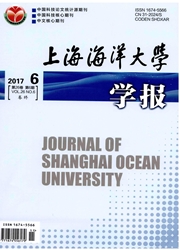

 中文摘要:
中文摘要:
江苏靖江段位于近长江口段,是长江刀鲚渔汛最集中的水域。为了弄清靖江段刀鲚的渔汛特征,本文于2008-2009年和2012-2013年对16艘持刀鲚捕捞许可证的渔船作了渔获量监测,分析了渔获量的时空变化及其环境影响。结果表明,靖江段单船日渔获数量NB和重量WB分别为(21±38)ind./d和(2.0±4.1)kg/d,单船全汛总渔获尾数Nt和重量Wt为(890±929)ind.和(92.3±91.1)kg。NB和Nt具有一致性的年变化趋势,以2013年的最大,其他年份比较接近。但WB和Wt的年变化趋势与渔获数量的年变化趋势有所不同,表现为2008-2012年间持续下滑,2013年显著增长。NB和WB在2-3月间均极低,但4月增至(23.0±31.3)ind./d和(2.4±3.5)kg/d,5月达(78.0±81.0)ind./d和(7.7±9.1)kg/d。ANOVA分析显示,西水域的年NB和WB分别为东水域的2.5和2.7倍。研究亦显示,靖江段刀鲚的WB与同日水温和最高潮位均呈极显著的正相关(P﹤0.05)。长江口外的水温提升,可能是刀鲚开始生殖洄游的重要环境诱导因子。而高潮期在靖江段出现最高渔汛,可能是因为所采用的固定刺网过滤了更多的江水所致。
 英文摘要:
英文摘要:
Jingjiang section of the Yangtze River, which is an important area for fishery resource conservation and reproduction of anchovy, is located at the connected region of lower reaches and estuary of Yangtze River. In 2002, Ministry of Agriculture of the People' s Republic of China decided to carry out fishing ban in Yangtze River. Fishing boats would not be allowed to fish Coilia nasus in Yangtze River unless they have special fishing license during the period of spring closed fishing season. The .fishing season of anchovy in Jiangsu section is approximately divided by the the Jiangyin Yangtze River Highway Bridge. We monitored daily variation in C. nasus catches based on log data of anchovy from 16 fishing boats in Jingjiang section of the Yangtze River from February to May in 2008, 2009, 2012 and 2013, and analyzed temporal and spatial variations in C. nasus catch as they relate to environmental factors. Results showed that the daily catch number (NB) and daily catches weight per boat (WB) ranged from 0 to 351 ind./d and from 0 to 39.5 kg/ d, with an average of (21 ±38) ind./d and (2.0 ±4.1 ) kg/d, respectively. Meanwhile, total annual catch ( Nt ) and total annual catch ( Wt ) per boat ranged from 130 to 3952 ind. and from 10.9 to 435.6 kg, with a mean of (890 ±929) ind. and (92.3 ±91. 1) kg in fishing season, respectively. N8 and Nt showed the similar annual variation trend, the maximal peak NB and Nt occured in 2013, and other years' N8 and Nt maintained at relatively low level. However, annual variation trend of catch weight was different from that of catch number. W8 and Wt continued to decline from 2008 to 2012, and then a significant rise was found in 2013. As fishing season progressed, the NB and W8 increased markedly. NB and WB were very low in February and March, then increased to (23.0 ± 31.3 ) ind./d and (2.4 ± 3.5 ) kg/d in April, and reached a maximum in May, Which were (78.0 ± 81.0) ind./d and (7.7 ± 9.1) kg/d, respectively. The ANOVA anal
 同期刊论文项目
同期刊论文项目
 同项目期刊论文
同项目期刊论文
 期刊信息
期刊信息
